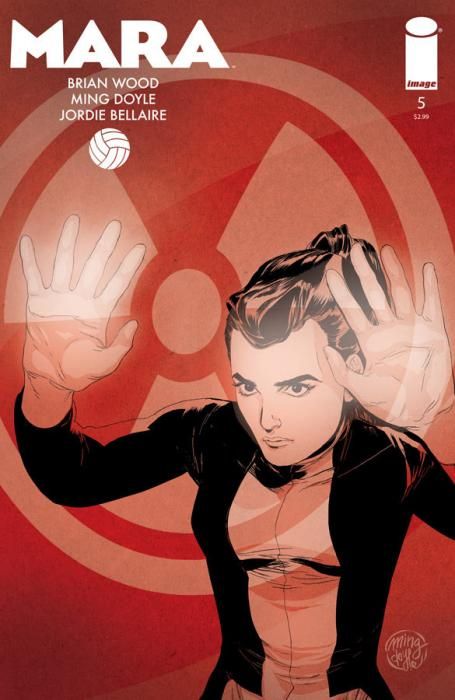"Mara" #5 by Brian Wood and Ming Doyle continues the story of Mara Prince, newly super-powered international athlete. The story undergoes its most dramatic twists so far as it explores themes of freedom in the age of media and the military state, and hostility and reverence as two sides of the same reaction to power.
"Mara" #5 opens with a full page-spread, with the reader seeing from Mara's eyes as she is suspended in outer space, looking down at her hands and realizing that she doesn't need the earth's atmosphere to live. Wood keeps it simple with a text box that says simply "She does not need to breathe," letting Doyle's art set a tone of limitless possibility and freedom. It's a stunning opener, and appropriate for a story about transcendence and limitations, both moral and physical.
Doyle's art for "Mara" #5 shows her usual flair for design and her distinctive fine line. As Mara floats in outer space, her dark hair blossoms in wiry ribbon-like swirls. As Mara descends back to earth, everything she encounters is at first monochromatically colored in either orange or blue, emphasizing Mara's reality versus the pale backdrop of humanity and the buzz of TV news. Doyle's human figures are a little stiff and her characters' facial expressions and body movements lack speed and dynamism, even as Mara arcs through the air in flight. However, this is partially remedied and overshadowed by Doyle's excellent composition skills and the detail of her backgrounds. The restrained, carefully placed feeling of Doyle's artwork also echoes Mara's calm demeanor and self-restraint.
Similarly, the narrative progression of "Mara" #5 is filled with action, but everything unfolds with a controlled, interlocking release like the clockwork of a ballet or a play. The story continues to be told in limited third-person point-of-view, such that the reader identifies heavily with Mara and only occasionally glimpses the thoughts and emotions of characters close to her. Even though Wood keeps some of Mara's full internal emotions shielded from the reader, he has deliberately built sympathy for Mara as a heroine of her own title. Even in "Mara" #5, there is a page and a half where Mara talks to some cute penguins. It's a nice interlude from otherwise tense action, but it also serves to build characterization. It was only upon re-reading that I noticed how Mara holds herself apart even from the penguins.
It's a subtle touch, and it only reinforces the first five pages of "Mara," which heavily foreshadow Mara's increasing distance from earthly concerns. Mara has already suffered the rejection by her beloved friend Ingrid, and in "Mara" #5, her remaining ties to humanity are further loosened.
Despite Wood's straightforward timeline and steady hints, two events in "Mara" #5 were shockers. Wood deliberately and masterfully plays with reader expectations and entrenched genre conventions. First, an important supporting character dies, and Wood makes the death quick, matter-of-fact and off-panel instead of drawn-out for dramatic effect. There is no window of opportunity for a rescue. Instead, the action jumps directly into the rapid aftermath.
Secondly, the last five pages are one long surprise. Wood and Doyle successfully expand what would usually be a one-page shocker into an epic build towards a final, brutally simple concluding image. The enjoyable unpredictability of the plot and Wood and Doyle's unusual approach to characterization should make the upcoming sixth and concluding issue a winner as well.

